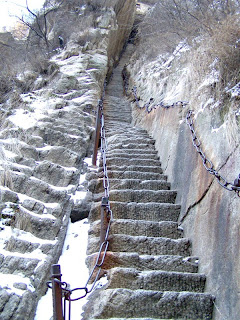Sexy Chinese cheongsam part 6
Find More:
Sexy Chinese cheongsam part 1
Sexy Chinese cheongsam part 2
Sexy Chinese cheongsam part 3
Sexy Chinese cheongsam part 4
Sexy Chinese cheongsam part 5
Saturday, May 03, 2008
Categories:
Chinese Culture,
Chinese Girls.
Author: Smith
Northern Great Mountain - Mount Heng
Hanging Monastery stands at the foot of Mt. Hengshan, 5 kilometers (3 miles) south ofHunyuan County, and 65 kilometers (40 miles) from downtown Datong City. Since it hangs on the west cliff of Jinxia Gorge more than 50 meters above the ground, it is called Hanging Monastery.
Hanging Monastery, built in 491, has survived more than 1,400 years. The extant monastery was largely rebuilt and maintained in the Ming Dynasty (1368-1644) and Qing Dynasty (1644-1911). The buildings were restored in 1900 and there are 40 wooden halls and structures linked by an ingenious system of pillars, posts and walkways.
How could a building like this withstand the winds and storms of so many years? Hanging Monastery is an architectural wonder. A unique mechanical theory was applied to building the framework. Crossbeams were half-inserted into the rock as the foundation, while the rock in back became its support. Seen from below, Hanging Monastery appears to be a tumble-down castle in the air. Inside, Hanging Monastery provides the same scene as other temples.
Construction experts from countries including Britain, Germany, and Italy, come to see the monastery. In their words, Hanging Monastery, which mixes mechanics, aesthetics, and Buddhism, is rare. The monastery and everything it symbolizes embodies a great cultural achievement of Chinese people.
The second attraction of Hanging Monastery is that it includes Buddhism, Taoism and Confucianism. Inside the monastery, the sculptures of Sakyamuni, Confucius and Laotzu appear together, which is unusual. There are 40 halls and cabinets, which contain about 80 sculptures made of copper, iron, terracotta, and stone. The features are vividly carved.
Why build a monastery like this? Location is the first reason; building a monastery on the cliff could shield it from floods. In addition, the mountain peak protects it from rain and snow; and the mountain around it also diminishes damage from long-time sunshine. The second reason is that the builders followed a principle in Taoism: no noises, including those from rooster crowing and dog baying; so from the upper ground, all noises drop away.
Friday, April 25, 2008
Categories:
China Scenery.
Author: Smith
Sexy Chinese cheongsam part 5
Find More:
Sexy Chinese cheongsam part 1
Sexy Chinese cheongsam part 2
Sexy Chinese cheongsam part 3
Sexy Chinese cheongsam part 4
Sexy Chinese cheongsam part 6
Friday, April 25, 2008
Categories:
Chinese Culture,
Chinese Girls.
Author: Smith
Southern Great Mountain - Mount Heng
Central Great Mountain - Mount Song
Western Great Mountain - Mount Hua
Eastern Great Mountain - Mount Tai
Thursday, April 24, 2008
Categories:
China Scenery.
Author: Smith
Central Great Mountain - Mount Song
Northern Great Mountain - Mount Heng Southern Great Mountain - Mount Heng Western Great Mountain - Mount Hua Eastern Great Mountain - Mount Tai
Wednesday, April 23, 2008
Categories:
China Scenery.
Author: Smith
Sexy Chinese cheongsam part 4
Find More:
Sexy Chinese cheongsam part 1
Sexy Chinese cheongsam part 2
Sexy Chinese cheongsam part 3
Sexy Chinese cheongsam part 5
Sexy Chinese cheongsam part 6
Monday, April 21, 2008
Categories:
Chinese Culture,
Chinese Girls.
Author: Smith
Western Great Mountain - Mount Hua
Usually tourists climb up the mountain assisted by the iron chains along the way and start their tour from Yuquan Yuan (Jade Spring Temple), one of the main Taoist temples in China located at the foot of Mt. Huashan. The path up the south peak is rumored to be the most dangerous hiking trail on earth, because it partly consists of thin wooden planks mounted on a cliff with chains to hold on.
Northern Great Mountain - Mount Heng Southern Great Mountain - Mount Heng Central Great Mountain - Mount Song Eastern Great Mountain - Mount Tai
Friday, April 18, 2008
Categories:
China Scenery.
Author: Smith

































































